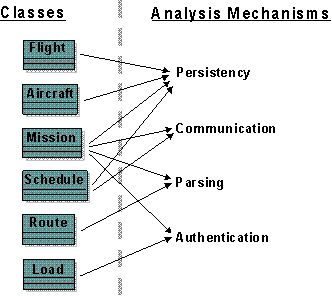Concepts: Analysis Mechanisms
Topics
Examples of Analysis Mechanisms 
- Persistency
For all classes whose instances may become persistent, we need to identify:- Granularity: Range of size of the objects to keep persistent.
- Volume: Number of objects to keep persistent.
- Duration: How long does the object typically need to be kept.
- Retrieval mechanism: How is a given object uniquely identified and retrieved?
- Update frequency: Are the objects more or less constant; are they permanently updated?
- Reliability: Shall the objects survive a crash of the process; the processor; or
the whole system?
- Inter-process Communication
For all model elements which needs to communicate with objects, components or services executing in other processes or threads, we need to identify:
- Latency: How fast must processes communicate with another?
- Synchronicity: Asynchronous communication
- Size of message: A spectrum might be more appropriate than a single number.
- Protocol, flow control, buffering, and so on.
Other typical patterns include:
- Message routing
- Process control and synchronization
- Transaction management
- Information Exchange
- Security
- Redundancy
- Error reporting
- Format conversion
Describing Analysis Mechanisms
The process for describing analysis mechanisms is:
- Collect all analysis mechanisms in a list
The same analysis mechanism may appear under several different names across different use-case realizations, or different designers. For example, storage, persistency, database, and repository might all refer to a persistency mechanism. Or inter-process communication, message passing, or remote invocation might all refer to and inter-process communication mechanism.
- Draw a map of the client classes to the analysis mechanisms
- Identify Characteristics of the Analysis Mechanisms
To discriminate across a range of potential designs, identify the key characteristics used to qualify each analysis mechanism. These characteristics are part functionality, and part size and performance.

The classes and component subsystems identified need to be mapped onto the identified Analysis Mechanisms: the arrows indicate that the class utilizes the mechanism. It is not uncommon for a client class to require the services of several mechanisms.
![]()